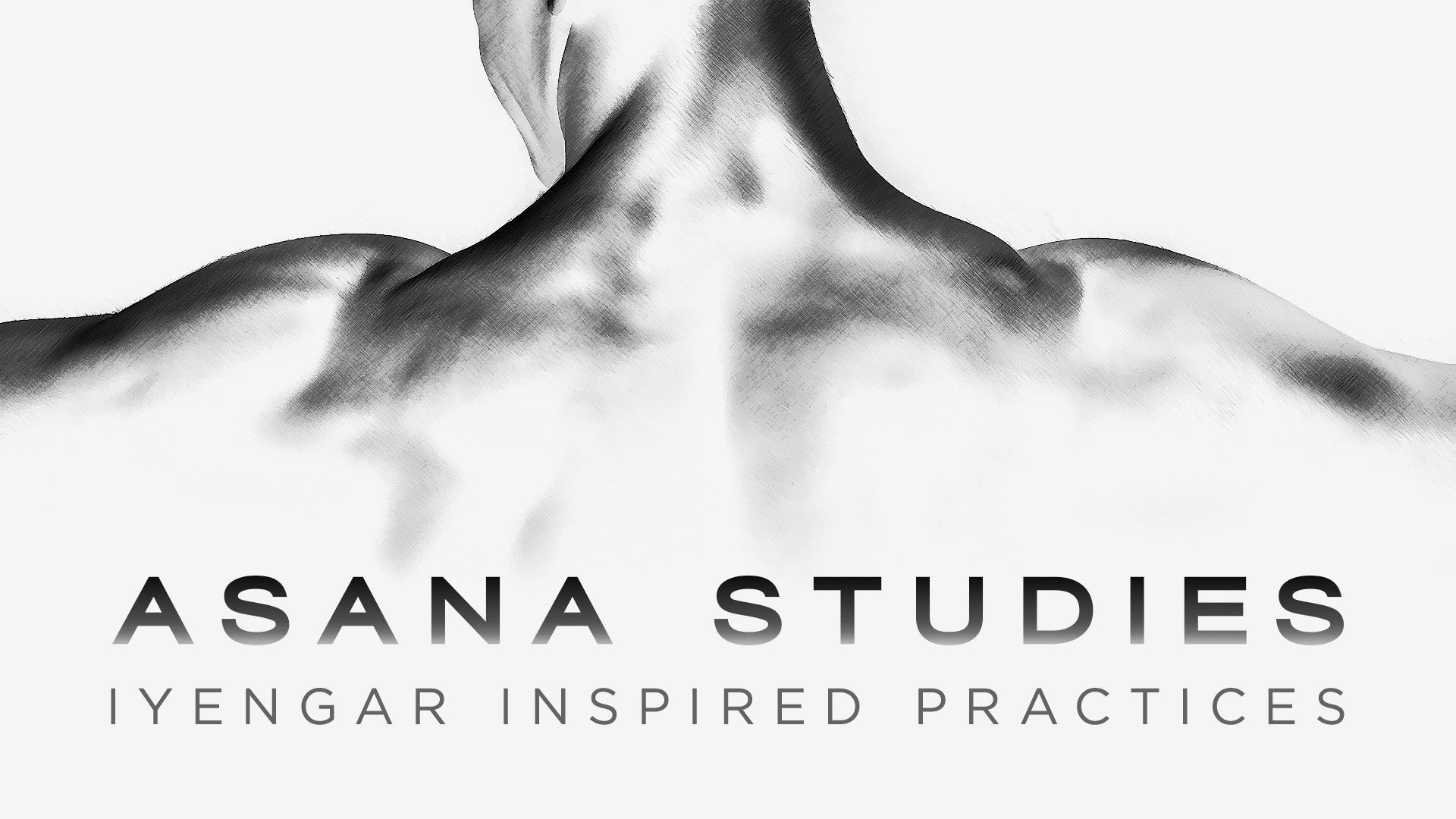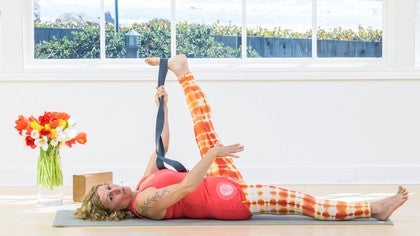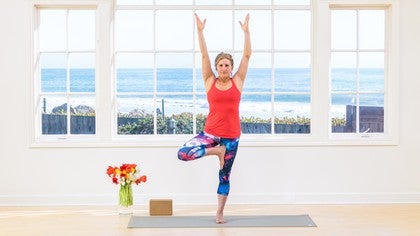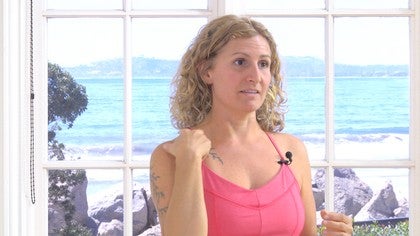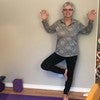Description
Transcript
Read Full Transcript
Hi, welcome back. So now we're gonna move on to the floor. I have a block and a strap I'm going to use, so if you have one of those, that would be helpful. We are, as I said in the last clip, we are going to play with the movements of the pelvis. It almost doesn't matter what movements you use.
It's almost finding a simple movement and a slow enough movement to get your body and your nervous system to sync into a more balanced rhythm. It's kinda hard to explain until we're moving, but if we're doing the rocking, and there's an asymmetry, if we do it slow enough, the body starts to sync. There's a point when the two halves start to relate to each other or relate, the movement becomes symmetrical. And that's really what we're looking for. So the use of breath and the use of slow movement is very helpful.
So coming on to your back. You wanna have your knees bent, feet flat on the floor, and your feet about sitting bone distance apart. And it does help to see if your feet are parallel. That one foot isn't turned out, one foot isn't turned in, that they're pretty much parallel, and that your legs are parallel. And then just take a moment to feel your feet settle, the soles of the feet relax, the back of the pelvis relax onto the floor.
Can even close your eyes, feel your breath. And just feeling for the sensation of your feet on the floor and the sensation of the back of the pelvis on the floor. So sometimes there's more heaviness on one side. Right now the right side of my pelvis feels heavier. My right foot wants to roll out a little more.
Just noticing. Good, and then taking that same awareness as I start to move. So simple rocking, we're gonna rock, we're gonna roll the back of the pelvis into the floor so the sitz bones lift. And then rolling the top of the pelvis forward. And more weight towards the tailbone and the sitz bones.
And then rolling more weight to the top of the sacrum. And the top of the pelvis, the back of the waist, is on the floor, and then rolling towards the sitz bones. Good, and going again, slowly enough so you feel. My right foot wants to press down, the left one doesn't. The pelvis wants to twist.
And I'm just rocking, nice and slow. Until they start to feel a little more similar, okay? My right foot and my left foot are starting to feel like they're engaged with the floor a little more equally. Right side of the lower back feels a little less stressed or short. So this is something that you can do just on the floor, just to help balance either the lower back to the belly, if the lower back is feeling tight or short, or you can do it in almost any asana, to help kinda find some freedom of movement either in the leg muscles, the back, the belly, the outer hips, or the inner thighs.
Okay, and then finding neutral. So next thing I'm gonna do, take my block. And put it between my legs, thighs, still keeping my thighs parallel. Good, and I'm going to try to initiate both legs, hugging the block at the same time. So the key is the initiation, the point where my body wants to hug the block becomes very important.
So I'm slowly thinking about it and then doing it. And then slowly releasing. So it's a very small movement, not a lot of effort coming in from the buttocks, from the backs of the legs. The inner legs are doing most of the work. There's not a lot of effort in the belly or the jaw.
Right, it's just this simple hugging the block and releasing. Quietly hugging, balancing the effort right and left side, and quiet releasing. Very simple, very slow. Letting the breath help, the in breath, and the out breath. Good.
And again, doing this movement until it starts to feel easier. There's no wobble between the legs. The movement feels symmetrical, balanced, easy. So I'm basically trying to balance the inner thigh right side to left side, and the pull on the pelvis. Good, so putting block off to the side, grabbing the strap.
Making a loop with the strap. (laughing) This is the hardest part. So you want the strap about (makes tsking noises), so when you have it on the thighs, you want the thighs to be about hip distance apart. Okay, and very similar in that the movement is slow. All right, I'm pressing out into the strap.
Again, I'm just gonna think about it. I'm gonna actually let my feet settle for a moment, let the back of the pelvis settle, feel the weight sink into the floor. And then as I start to initiate my right and left side moving same time, same effort. And then releasing same effort or same speed. And then pressing out into the strap.
And then releasing. And again, just nice and slow, simple, simple movement. And you'll feel the effect, you'll feel how, when the outer thighs engage, you'll feel the effect all the way back to the edges of the sacrum. And just balancing, right and left. Nice and simple, breath simple, shoulders easy.
Feet relaxed, buttocks is relaxed, belly is relaxed. Good, good, okay. Strap comes off. And strap actually, let's take the strap now. Oops.
And just ignoring the loop. So that same neutral point feet balance, back of the pelvis balance, so that it becomes a place that you start to recognize in your body. So when I take my right foot now and put it up on the strap, I wanna be able to put my leg in a place that I still feel the back of the pelvis weighted, so that the weight doesn't come onto the lumbar spine or the lower back. So maybe even letting the leg move far enough away until you feel it, the weight of the leg right on the back of the pelvis. Good, holding the strap easily, right hand and left hand.
And then let's slowly, we're gonna just slowly slide that left leg out. And so as you do, it's just gonna pull more weight towards the base of the pelvis, towards the sitz bones and the tailbone, which is fine. And if you need to keep that left leg bent, please do so. Good, left leg straight, right leg straight if you can. Arms straight, good.
Just quietly just letting the back of the leg soften, letting the back soften, maybe even a little pull of that left leg against the floor, just pulling it back into the floor so that the left leg relates to what's happening in the spine, or the length in the spine. Good, and then I'm gonna take both straps into my right hand, good. So my left hand is gonna remind my left leg to keep pulling back to the floor. So there's that sense of weight, or there's that sense of heaviness in the whole pelvis that's initiated from the left leg. And then I'm gonna take the right leg out to the side.
So if your body isn't quite ready, if you feel yourself tipping to the right leg, then just stay where you can easily go, where you can easily hold that. And then maybe you can take that right leg out a little further, keeping that left leg, left hip, left side of the waist, left side of the rib cage anchored. And right leg out a little further. Good, good. And then let's take that leg up.
Both straps come into the opposite hand. So that left leg is still pulling back towards the floor. And now I'm gonna take this right leg across. So I'm gonna keep the hip on the floor just for a breath or two, just to feel this, the outer line of the leg, soften. And prepare before we go the rest of the way.
And then now I can turn. My pelvis turns away from the rib cage, and I'm coming on to that outer left hip. Good. So left leg is still pretty active. It's still trying to hold the foundation of the pose.
But I'm standing through that left leg. Good, and then coming back to neutral. Good, and bending that right leg, right foot on the floor. So basically, I just stretched the back of the leg, the inner leg, and the outer leg. Again, just trying to find a kinda more ease, or release some of the postural patterns in the leg.
And now left foot up on the strap. Again, letting the leg come back over or rest on top of the back of the pelvis. Good, and then when I'm ready, straightening that right leg. Right leg feels as if it's pulling back into the floor. So there's a sense of weight on the pelvis.
No weight on the lower back. Puff of air in the lower back. Good. And just letting your breath help you soften the tissue in the back of that leg, the lower back, back of the hip, softening the shoulders, the neck, the face. Good, and then both straps into your left hand.
So my right hand maybe reminding my right leg to stay quite heavy, the right thigh to stay quite heavy. Good, the whole side, the right side of the body's weighted down to let that left leg slowly travel out. And again, if you feel like you're falling to the leg, then just go as far as you can go. And slowly let that right inner leg open, or left inner leg. Good.
And slowly come back, both straps in the right hand. And I'm just taking this left leg across to the right, just enough so that I feel the outer line from the ankle to the outer edge of that left sacrum, left side of the sacrum. There's probably a little bit of a pull. I'm just gonna wait until it softens. And then keep going.
Good, rib cage stays pretty balanced on the floor. Good, that left chest stays open. The right leg is still holding the foundation of the pose. Good, legs are long, spine is long, breath is long. And then let's slowly roll back on to the back of the pelvis.
Good, bend that left leg, bend the knees, both feet on the floor. Okay, and again, just feeling the placement, feet, back of the pelvis. Okay, so now bringing the feet together, knees together. Good, we're gonna slowly let the knees fall away from each other. So I wanna keep the weight in my feet and in my pelvis.
So if I go fast, then the knees take over, and the momentum pulls the knees open. But I wanna go slow. Again, just to keep pelvis weighted, feet weighted. And then come back up. So if the inner legs, if there's resistance in the inner legs, just go as far as they can go, and then come back up.
And go out. And come back up. And one more time, and going out. And come back up. All righty, next one we're gonna do is left leg stays pretty neutral, the pelvis stays pretty neutral, but finding the place where the body isn't really struggling to maintain neutral or stability.
All right, we're gonna let this right leg fall open. And the left side's trying to allow it. Left leg, left hip. Good, and just letting all of that open. And then I'm gonna try to sneak my right leg behind, my right foot behind my left foot, over to the left side of my mat.
Maybe grab my foot with my hand. And let the leg fall open even more. Good, and then I'm gonna press into my left foot and turn the pelvis to the right. And release. And keeping the leg falling open, gonna slide out, step that right foot on the floor.
Okay, let's do it again. Right leg travels out, right knee falls open. Good, sliding that right foot behind the left foot, reaching it over into the hand. Good, and then letting the leg fall. Good, stepping into the left foot, turning the pelvis to the right, and releasing.
Good, and slowly unwind and come back. Okay, one more time, right leg travels out. Good, keeping that open, the front of the leg, the inner leg open, walking that right foot across to the left, good. Finding the foot if you can, and stepping into the left foot and turning the pelvis to the right. And so now just trying to free up the front of the leg.
And step back to neutral. Just take a moment, feel neutral for a moment. And then other side, left leg travels. Oh, good. Right leg tries to hold, or the rest of the body tries to hold neutral as easily as possible.
Good, and just letting that leg fall open. And then walking left foot behind the right foot to the right side of the mat. Finding the hand if you can. Good, letting the leg fall open. So if this is a difficult move for you, take it in pieces.
Do what you can, find the place where it's still easy, it still makes sense to the body. So if it's easy enough for the body to understand, the next time it does it, it will usually go further. Let the left knee fall open, let the left foot walk behind the right foot. And then turning the pelvis to the left. Good, and release.
And release. Good, one more time. Knee falls open, good. Foot slides behind the right foot. Good, that left leg is still falling open.
The front of the leg and the inner leg are trying to find some length, softness. Good, and then turning into that. And releasing out. Good. And release.
So just feeling the feet on the floor, feeling the back of the pelvis on the floor, and just notice that there is a lack of sensation, or less sensation around the pelvis, or more ease. Or maybe you just feel more relaxed in your whole body. So let's take one more kind of rocking, we'll do three. Rocking back, so lower back pressing into the floor. And then sitz bones rolling towards the floor.
And just notice the difference from the first time. Good, and last one. Lower back pressing into the floor, and sitz bones pressing into the floor. Good, and then take another few moments just to notice your breath. Let your body receive the work.
'Cause it's really, it's not exercise. It's really trying to sync the nervous system with the body. Right, you're trying to allow the nervous system that might be running at a very different speed with the mind, with the thoughts, rather than with your movements or what your body is able to do. Good, and then when you're ready, you can either stay there, or you can roll up to sit. Good, and thank you very much.
Asana Studies: Padma Borrego
Comments
You need to be a subscriber to post a comment.
Please Log In or Create an Account to start your free trial.
